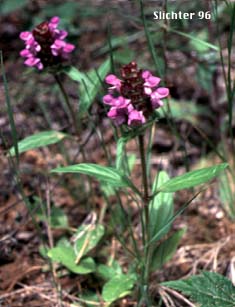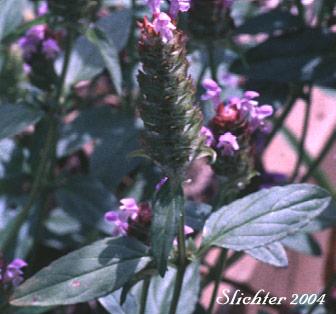
Prunella vulgaris

 The
photo at right shows Prunella vulgaris ssp. vulgaris, the introduced species of
self-heal as seen in the author's garden in Gresham, OR.
The
photo at right shows Prunella vulgaris ssp. vulgaris, the introduced species of
self-heal as seen in the author's garden in Gresham, OR.
Self-heal is a fibrous-rooted perennial with several erect, spreading, or prostrate stems from 10-50 cm long. The leaves and stems range from being glabrous to having lines of fine, short hairs throughout. The few leaves are usually found on the square (in cross-section) stems, although a cluster of basal leaves may be present. The stem leaves are opposite. All leaves are petiolate with lanceolate, elliptic, or broadly ovate blades measuring from 2-9 cm long and 0.7-4 cm wide. The lower leaves tend to be wider and have more rounded bases than the upper leaves. The petioles vary from short to long and often have ciliate margins
The inflorescence is a short, dense spike of flowers at the terminus of the stems. The inflorescence ranges from 2-6 cm long and measures from 1.5-2 cm thick. The semicircular bracts are bout two-thirds as long as the calyx. The calyx is green or purple and measures from 7-10 mm long. The calyx lobes are strongly irregular (with 2 separate lobes and 3 that are fused into one) with the pair of free lobes about twice as long as the tube. The corolla is usually a blue-violet color, but may also be pink or white. The corolla tube is roughly the same length as the calyx, or sometimes slightly longer. The two lips are short, the upper longer and hooded while the central lobe of the lower lip is has toothed edges.
Prunella vulgaris ssp. lanceolata: Native species. Leaf blades of the midstem leaves about 3 times longer than wide with a tapered base. The stems are ascending to erect.
Prunella vulgaris ssp. vulgaris: Introduced species. Leaf blades of the midstem leaves about 2 times longer than wide, the base of the blade rounded. The stems are more apt to be prostrate or ascending only weakly.
Self-heal is found from sea level to moderate elevation in the mountains. It may be found in moist places, and occasionally as a "weedy" species in disturbed areas such as fields, roadsides, gardens, and lawns.
Self-heal is found across much of North America, where it is native. However, it may also be found in Europe.
